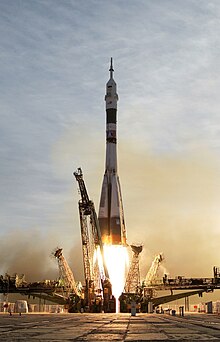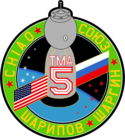Sojus TMA-5
| Missionsemblem | |||
|---|---|---|---|
 | |||
| Missionsdaten | |||
| Mission | Sojus TMA-5 | ||
| NSSDCA ID | 2004-040A | ||
| Raumfahrzeug | Sojus 7K-STA (GRAU-Index 11F732) Seriennummer 215 | ||
| Rufzeichen | Тянь-Шань („Tianshan“) | ||
| Masse | 7250 kg | ||
| Trägerrakete | Sojus FG (GRAU-Index 11A511FG) | ||
| Besatzung | 3 | ||
| Start | 14. Oktober 2004, 03:06:00 UTC | ||
| Startplatz | Baikonur 1/5 | ||
| Raumstation | ISS | ||
| Ankopplung | 16. Oktober 2004, 04:15:32 UTC an das Modul Pirs | ||
| Abkopplung | 24. April 2005, 18:44:40 UTC vom Modul Sarja | ||
| Landung | 24. April 2005, 22:08:00 UTC | ||
| Landeplatz | 85 km nördlich von Arkalik | ||
| Flugdauer | 192d 19h 1m 59s | ||
| Erdumkreisungen | 3026 | ||
| Umlaufzeit | 89,6 min | ||
| Apogäum | 238 km | ||
| Perigäum | 204 km | ||
| Mannschaftsfoto | |||
 v. l. n. r. Schargin, Scharipow und Chiao | |||
| ◄ Vorher / nachher ► | |||
| |||
Sojus TMA-5 ist die Missionsbezeichnung für den Flug eines russischen Sojus-Raumschiffs zur Internationalen Raumstation (ISS). Es war der neunte Besuch eines Sojus-Raumschiffs bei der ISS und der 115. Flug im Sojusprogramm.
Besatzung
Startbesatzung
- Salischan Schakirowitsch Scharipow (2. Raumflug), Kommandant (
 Roskosmos/
Roskosmos/ Russland)
Russland) - Leroy Chiao (4. Raumflug), Bordingenieur (
 NASA/
NASA/ Vereinigte Staaten)
Vereinigte Staaten) - Juri Georgijewitsch Schargin (1. Raumflug), Bordingenieur (
 Roskosmos/
Roskosmos/ Russland)
Russland)
Ersatzmannschaft
- Waleri Iwanowitsch Tokarew, Kommandant (
 Roskosmos/
Roskosmos/ Russland)
Russland) - William S. McArthur, Bordingenieur (
 NASA/
NASA/ Vereinigte Staaten)
Vereinigte Staaten)
Rückkehrbesatzung
- Salischan Schakirowitsch Scharipow (2. Raumflug), Kommandant (
 Roskosmos/
Roskosmos/ Russland)
Russland) - Leroy Chiao (4. Raumflug), Bordingenieur (
 NASA/
NASA/ Vereinigte Staaten)
Vereinigte Staaten) - Roberto Vittori (2. Raumflug), Bordingenieur (
 ESA/
ESA/ Italien)
Italien)
Missionsüberblick

Dieser Flug war eine Crewaustauschmission zur ISS und der 25. bemannte Flug zu dieser Station. Die auf der Raumstation arbeitende Expedition 9 wurde durch die Mannschaft der Expedition 10 abgelöst. Sie bestand aus dem russischen Kosmonauten Salischan Scharipow (Kommandant) und dem US-Amerikaner Leroy Chiao (Bordingenieur). Zusätzlich flog der Kosmonaut Juri Schargin mit, der nach einem kurzen Stationsaufenthalt von knapp acht Tagen am 24. Oktober 2004 mit der Sojus TMA-4-Landekapsel zur Erde zurückkehrte.
Der Start erfolgte mit einer Trägerrakete vom Typ Sojus-FG vom Weltraumbahnhof Baikonur am 14. Oktober 2004 um 03:06:00 Uhr UTC.
Die beiden Raumfahrer Scharipow und Chiao arbeiteten als 10. Stammbesatzung auf der ISS und führten wissenschaftliche Experimente durch. Außerdem erhielten sie Besuch von zwei Progress-Raumtransportern.
Weitere Flugdaten
- Kopplung ISS: 16. Oktober 2004, 04:16 Uhr UTC (an das Modul Pirs)
- Abkopplung ISS: 29. November 2004, 09:29 Uhr UTC (vom Modul Pirs)
- Kopplung ISS: 29. November 2004, 09:53 Uhr UTC (an das Modul Sarja)
- Abkopplung ISS: 24. April 2005, 18:44 Uhr UTC (vom Modul Sarja)
Siehe auch
Weblinks
- Sojus TMA-5 bei spacefacts.de
- Sojus TMA-5 im Russian Space Web
- Sojus TMA-5 bei space.kursknet.ru (englisch/russisch, archiviert 2016)
- Sojus TMA-5 in der Encyclopedia Astronautica (englisch)
- Sojus TMA-5 im NSSDCA Master Catalog (englisch).
Auf dieser Seite verwendete Medien
Astronaut Leroy Chiao (right), Expedition 10 commander and NASA International Space Station (ISS) science officer; cosmonaut Salizhan S. Sharipov (center), Russia's Federal Space Agency Expedition 10 flight engineer and Soyuz commander; and Russian Space Forces cosmonaut Yuri Shargin (left) donned their launch and entry suits and climbed aboard the Soyuz TMA-5 spacecraft October 5, 2004, at the Baikonur Cosmodrome in Kazakhstan for a dress rehearsal of launch day activities leading to their liftoff October 14 to the ISS. Chiao and Sharipov, the first crew of all-Asian extraction, will spend six months on the Station, while Shargin will return to Earth October 23 (U.S.A. time) with cosmonaut Gennady I. Padalka, Expedition 9 commander, and astronaut Edward M. (Mike) Fincke, NASA ISS science officer and flight engineer, who have been in space since April.
Backdropped by a blanket of clouds, the Soyuz TMA-7 spacecraft departs from the International Space Station carrying astronaut William S. (Bill) McArthur Jr., Expedition 12 commander and NASA space station science officer; Russian Federal Space Agency cosmonaut Valery I. Tokarev, flight engineer; and Brazilian Space Agency astronaut Marcos C. Pontes. Undocking occurred at 2:48 p.m. (CDT) on April 8.
Logo of the Russian Federal Space Agency, commonly called Roscosmos, and abbreviated as FKA and RKA.
Logotype of the European Space Agency (ESA). Intended for use at small sizes only, but the official, more detailed one seems eligible for copyright.
This Soyuz TMA-5 patch was designed by Alex Panchenko:
"I've started design works of patches for Soyuz TMA-5 (ISS-10 flight) back in July 2004, when first sketches - drawings made in Starbucks coffee and later presented them for approval to Soyuz commander S. Sharipov. It was still not clear who is going to be third crew member of Soyuz and in this case I was preparing for Soyuz TMA-5 flight design in two variants (with name of Polonsky and with name of Shargin - both candidates on third seat in Soyuz).
During design work with Soyuz TMA-5 patch my idea was to present Soyuz panels as symbolic flags of Russia and United States, and base of design is a window view outside. Crew names are in the same order as their actual seats inside Soyuz. Commander S. Sharipov in center, L. Chiao on the left from commander and Y. Shargin on the right side."
The Soyuz TMA-5 spacecraft blasts off from the Baikonur Cosmodrome in Kazakhstan October 14, 2004, carrying astronaut Leroy Chiao, Expedition 10 commander and NASA International Space Station (ISS) science officer, cosmonaut Salizhan S. Sharipov, Russia's Federal Space Agency flight engineer and Soyuz commander, and Russian Space Forces cosmonaut Yuri Shargin to the ISS. The crew will dock to the Station on October 16, and Chiao and Sharipov will replace the current Station crewmembers, cosmonaut Gennady I. Padalka, Expedition 9 commander, and astronaut Edward M. (Mike) Fincke, NASA ISS science officer and flight engineer, who will return to Earth October 24 with Shargin.












